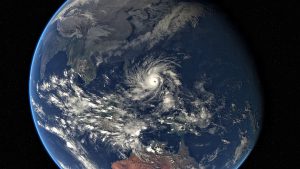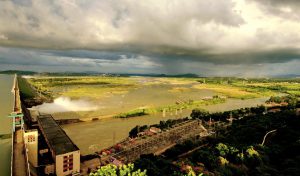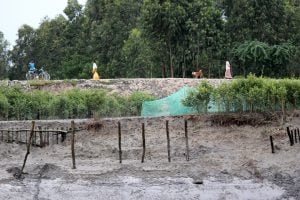Siddharth Singh is an unusual writer on environmental issues, something he makes clear in his acknowledgements, which begin with, “I am not an environmentalist.” His background is in energy, mobility and climate policy, and his graduate degree was in international relations from the School of Oriental and African Studies, University of London. He was a German Chancellor Fellow in 2016-17 under Angela Merkel’s office.
The catastrophic levels of air pollution – and Singh’s opening chapter makes it clear how catastrophic it actually is – in Delhi where he works, and India as a whole, is making everybody something of an environmentalist.

Singh spoke in an interview on the key issues in his book. Edited excerpts:
The timing of your book is scarily apt, as Delhi struggles to breathe, and while you tell your parents in the dedication of your book not to panic, you do tell your readers to do so. Should we panic?
To my parents, I say don’t panic because they get worried and call repeatedly worried about my health, but there are people who should panic, or at least be concerned enough to demand change. I am not talking about the poor, who do not have the choice except to work in difficult conditions, but privileged people like the 10,000 or so who turn up for the Delhi half marathon when doctors have warned about the effects of this type of exercise in heavily polluted air. These people should be panicking, and instead of business as usual, be demanding change, since they have the clout to do so.
But, as you recount in your book, that privilege may be part of the problem as people isolate themselves from the ill effects of air pollution.
I have walked into the office of bureaucrats to see two-three air purifiers installed. Companies already do so in their offices, as do embassies, and private schools are also doing this. In a way, we have become inured to the fact that tap water is undrinkable because the privileged have found ways to access filtered water, so the demand for change has been muted.
Air pollution is different, and you cannot escape it as much as you can escape lack of state provisions in security, education, and health through private security, private education and private hospitals, but you can insulate yourself for sixteen hours a day at home and at office.
Is this the reason that we don’t have change, because the privileged isolate themselves?
Not wholly. You have to understand that India is a poor country. No politician has ever lost elections because of air pollution, but they have lost when they could not provide jobs, or when the price of onions rose. Furthermore, the loss to the economy – and there are real and large losses due to the health crisis – is very spread out. It is not that a hundred people lost their jobs, but that there is a 5% drop in productivity across the board. This is harder to see, and thus does not become a political issue.
In China it did, and the country acted, cleaning up its air to some degree. Are there lessons for India to learn?
For China, it was as much about a loss to the economy as it was about a loss of face, something that China cares deeply about. China acted before the Beijing Olympics in 2008 and the Expo in 2010, at which time its pollution issue received a lot of negative coverage in international news. Also China used a lot of coal for heating buildings, and it managed to make that big switch to natural gas.
There were schools that went without heating in the bitter Beijing winter until the switch could be made. This would be impossible in India, and we don’t have an easy switch like this. (In his book, Singh talks about the big switch to the use of natural compressed gas for public transport in Delhi in 2001, and the efforts of the current government to encourage the use of natural gas for domestic use.)
What the Chinese did and which India can learn from, though, is how they framed the issue and made noise at the highest levels. They called it the Blue Sky initiative and thus the public discourse was towards a visible change. In India, too, we need such an umbrella policy and institution to look at the issue.
One takeaway from your book, especially with the comparisons with London and Los Angeles, is how long it takes real change to happen. Is that something we need to deal with, this smog for years before things change?
It will take time, maybe a decade, for real change, although we can probably do away with the worst days. This is primarily because it needs to be coordinated effort, and as I have documented in the book, India’s political and administrative set up is intensely fragmented in how it responds. It is not that people do not know of the problems, but that is not enough to create action.
Secondly, there is no silver bullet. It is not one sector – transport, industry, or agriculture – that is the key to the problem, but all of them. And focussing on one alone will not deal with the issue. Each sector has a technical limit to what it can achieve before it hits serious economic issues.
This thin division of both contribution and impact is what makes this problem so challenging in India, it is also why we need an overarching policy, as well as a body that can coordinate between the Centre and the states, and have the political heft to make changes. The Swachh Bharat scheme [the national wide campaign to clean up India] is something like that, it has political capital, and frames the issue in terms of national pride but also economic incentive – more tourists will travel to a cleaner country. We need that idea to be expanded to cover water and air as well, with tangible and measurable goals that politicians across political lines can buy into.
You have spoken a bit about nuclear power. Is that a silver bullet?
No, but I think our difficulty in thinking about nuclear power illustrates a point. Nuclear power has a perception problem. There have been very, very few nuclear accidents, with few casualties, and none at all in the latest generation of nuclear plants. And yet we all think of a mushroom cloud when we think of them.
On the other hand, a recent study showed that the use of coal kills 170,000 Indians annually, not counting accidents. If that had happened due to nuclear power, we would have shut such technology immediately, but we do not think of coal in this way. We have to.
Lastly, you have focussed a lot on Delhi. Why is that?
The problem is India-wide, although for geographical reasons I outline in the book, north India is worst affected. But I am looking at Delhi as a sandbox. This is where different policies have been tried, where the switch to CNG happened for public transport, and the Delhi government tried the odd-even scheme.
It is here that we have the measuring devices and the activism. Understanding the problems of Delhi and what works and what don’t may help us understand how we respond elsewhere. We have to start somewhere.
![<p>As Siddharth Singh’s book hit the bookstores Delhi was experiencing the worst air pollution in years [image by: Siddharth Singh]</p>](https://dialogue.earth/content/uploads/2018/11/SS2.jpg)








